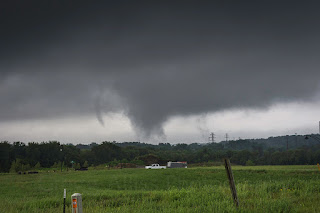We were planning a relaxing night sitting in front of a large bonfire at my sister and brother-in-law's acreage near Shueyville, Iowa on Saturday evening, June 9, 2018. But as the time for the event drew nearer, mother nature had other ideas. My photography equipment was intended for capturing images of the bonfire but now I turned my attention to a severe storm cell suddenly appearing on the western horizon and approaching fast. The storm cell in the image above--captured at 8:03 pm CDT--was about 25 miles distant. In fact, in just about five minutes it would go tornado-warned. The most intense area of the storm at this moment was located near the town of Luzerne, in SW Benton County.

8:21 pm. As the storm drew nearer, it began to sport huge elongated crepuscular rays above its cloud tops. I had never seen rays this big and long emanating from behind a storm cloud--almost like racing stripes! Crepuscular rays form when large objects such as mountains or clouds block sunlight. The storm cell, seen above and now tornado-warned, was located about 20 miles distant near Blairstown in southern Benton County.
8:38 pm. The approaching storm cell's anvil was now occupying most of the western sky. The most intense area was only 15 miles away, located near the town of Norway, in southern Benton County.
Radar screen capture corresponding to the photo above it, showing our location (target icon at right).
Soon after, the closest area of the storm system lost its tornado warning, but a new area a few miles farther back near Newhall, Iowa now attained one. This image, captured around 9:06 pm and backlit by a lightning flash, looks northwest in that direction.
One minute later. The camera has apparently captured a wall cloud with a funnel (at left under the tree branches and above the houses). An inflow cloud feeds into the storm from the upper right.
9:10 pm. iPhone video frame capture showing the wall cloud, backlit from a lightning flash.
A radar screen capture corresponding to the time of the video frame capture above. The white target icon is our position, with the arrow pointing to the area of interest.
9:12 pm. More CC lightning in this potent area of the storm.
Having retreated from the property line fence and back toward the house for safety purposes, I paused to capture the pond with backlit CC lightning at 9:17 pm (above), and 9:21 pm (below).
Nikon D7200 DSLR camera. Both pond images were captured with a Tokina AT-X Pro DX II 11-16mm f/2.8 lens at 1.6 seconds, f/3.5, 400 ISO and 11mm focal length. Vanguard Alta Series 70 tripod.
Read more...


























































